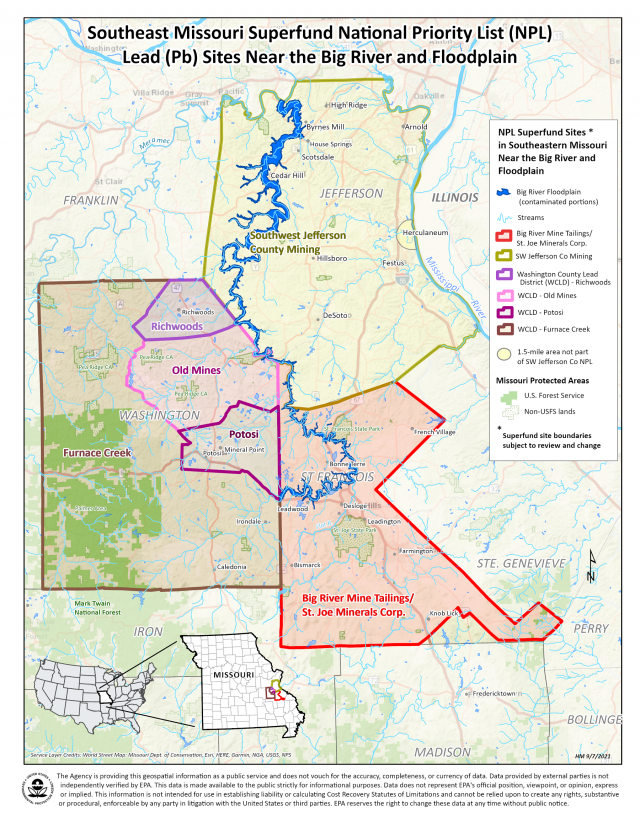Superfund National Priorities List (NPL) Sites Near Big River and Floodplain; St. Francois, Jefferson, and Washington Counties, Missouri – Fact Sheet, September 2021
Big River Watershed Project Update
EPA Actions on Lead Contamination
The U.S. Environmental Protection Agency (EPA) Region 7 is investigating lead contamination in the river and floodplain throughout the Big River watershed. The river runs north through St. Francois, Washington, and Jefferson counties in southeastern Missouri.
Lead is a toxic metal that is harmful if inhaled or swallowed and can pose serious health risks, particularly to children 7 years old and younger, as well as pregnant women and nursing mothers. Lead is the primary contaminant of concern at this site. If you live or recreate along the Big River, you are at risk of being exposed to lead and other toxic metals.
| To reduce lead exposure to families and children, EPA, landowners, federal, state, and local partners have been working together to investigate lead contamination along the Big River and floodplain. EPA Region 7 is developing a Proposed Plan to address the lead contamination. A cleanup decision has not been selected at this time. EPA is currently evaluating alternatives and working to determine preferred cleanup actions for the Big River. |
EPA is concluding the Remedial Investigation (RI) and Feasibility Study (FS) along the Big River. Once these documents are complete, the Proposed Plan and supporting records will be made available to the public.
The Proposed Plan will explain various options for cleanup, highlight EPA’s Preferred Alternative, and request public comments. The primary focus of the Proposed Plan includes the St. Francois County portion (Big River Mine Tailings National Priorities List [NPL] Site, Operable Unit 2) and the Jefferson County portion (Southwest Jefferson County Mining NPL Site, Operable Unit 4). Only a small portion of Washington County is included in the Proposed Plan; therefore, this portion is included in the descriptions of the other two sites.
Public comments are important to EPA as it considers its remedy decision. Comments will be addressed in the Responsiveness Summary when the Interim Record of Decision is published.
Throughout this process, sampling of river sediment and residential yards will continue at no cost to property owners.
Background

The Big River is located within the Old Lead Belt, which was one of the world’s largest lead mining districts where mining began in the early 1700s and produced more than 8 million tons of lead.
The Big River flows north through the Old Lead Belt, which is divided into multiple NPL Superfund sites. (See map at right.)
The NPL is the list of sites of national priority among the known releases or threatened releases of hazardous substances throughout the United States. The NPL is intended primarily to guide EPA in determining which sites warrant further investigation.
It has been estimated that some 250 million tons of hazardous mining waste (such as lead mill waste tailings and chat) was generated in the Old Lead Belt from processing lead.
Lead mine waste has been dispersed throughout the area from water and wind erosion; and spread as residential fill material, applied as treatment on icy roads, and used as agricultural lime. Runoff from these applications, along with historic releases directly from the mine waste piles, has contaminated the Big River and was transported downstream and spread onto the floodplain. EPA and Missouri state agencies have been addressing lead-contaminated soils in these counties for over three decades.
Administrative Record File Available
The Administrative Record (AR) file is the official site file that contains technical documents with respect to response actions at this site.
To review the AR files for these sites, please visit the EPA Site Profile Pages for the Big River Mine Tailings/St. Joe Minerals Corp. Superfund Site and the Southwest Jefferson County Mining Superfund Site (see Site Documents & Data on both pages).
Work in Your Community
EPA is conducting residential yard cleanups in various communities across the Old Lead Belt in southeastern Missouri. Lead contamination in surface soils requires remedial actions to clean up yards at residential properties, including child high-use areas. Contact EPA about testing your yard and private well.
Annual Blood Lead Testing
The only way to know if your child has an elevated blood lead level is to have his or her blood tested. Talk to your pediatrician, general physician, or local health department about testing your child.
For more information on blood lead testing for children, you can contact:
- St. Francois County Health Center, 573-431-1947
- Jefferson County Health Department, 636-797-3737
- Washington County Health Department, 573-438-2164
Additional Information
Read a prior Fact Sheet about the Big River and floodplain.
For more information about lead, visit:
EPA Contact Information
EPA encourages community members to ask questions and report any concerns about this site. Contact EPA for more information about community involvement, technical assistance opportunities, to receive site updates, or to join EPA’s site contact list.
Questions, comments, or requests for site information can be submitted to EPA:
Elizabeth Kramer
Community Involvement Coordinator
U.S. EPA Region 7 (ORA/OPA)
11201 Renner Boulevard
Lenexa, KS 66219
Phone: 913-551-7186
Toll-free: 1-800-223-0425
Email: kramer.elizabeth@epa.gov
